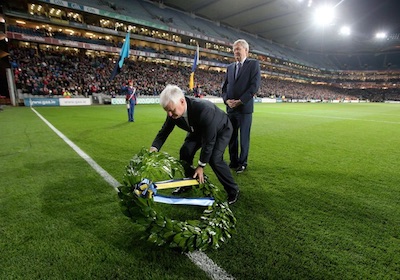
The Gaelic Athletic Association (GAA) has marked the 95th anniversary of the British army killings of 14 people at a sports match in Dublin, which became known as Bloody Sunday.
British troops randomly opened fire into the crowd at a GAA game on Sunday 21 November 1920 during the Irish War of Independence.
The association marked the anniversary of the Croke Park stadium attack before Saturday’s International Rules test between Ireland and Australia.
The names of the victims were read out before the match, and 14 flames were lit in their memory.
The dead included 24-year-old GAA player Michael Hogan, after whom Croke Park’s Hogan Stand is named. Senior GAA staff laid a laurel wreath at the spot where he was shot, followed by a moment of silence.
The event is often referred to as the original Bloody Sunday, to distinguish it from the 1972 British Army massacre of 14 civil rights demonstrators in Derry.
GAA Árd Stiúrthóir Páraic Duffy said: “The events of Bloody Sunday on November 21, 1920 are as much a part of the history of Croke Park as any of the epic sporting contests which have taken place there since Gaelic games were first played on Jones’ Road.
“The tragic loss of 14 lives on that fateful day, when almost 15,000 turned up to enjoy a football game between Dublin and Tipperary, was a harrowing moment for the Association, and while we have thankfully left those dark days behind us, it is only fitting that we honour the memory of those who were killed.
“The memory of Tipperary’s Michael Hogan, who was 24 when he was killed, has lived on through the famous stand at Croke Park that bears his name. We are happy to play a part to ensure the names of the other 13 lives lost at Croke Park on Bloody Sunday – Jane Boyle (26), James Burke (44), Daniel Carroll (30), Michael Feery (40), Tom Hogan (19), James Matthews (48), Patrick O’Dowd (57), Jerome O’Leary (10), William Robinson (11), Tom Ryan (27), John William Scott (14), James Teehan (26) and Joe Traynor (21) are also honoured.”
VICTIM RECALLED
A gravestone was also unveiled at grave of Jane Boyle in Glasnevin Cemetery on the 95th anniversary of her death in Croke Park on Bloody Sunday.
Jane Boyle, the only woman out of 14 people killed by Crown forces at the Dublin-Tipperary football challenge match on 21 November 1920 in Croke Park.
Ms Boyle was attending the match with her fiancé Daniel, and the couple were due to get married five days later. Initially it was reported that she had been trampled to death, but records released in 1999 revealed that she had been shot.
Her great-nephew Richard Staveley led the effort to have a gravestone erected when he discovered his great-aunt’s plot in Glasnevin Cemetery was unmarked.
His effort received the support of the GAA and the extended Boyle family, many generations of which attended the ceremony at the graveside today.
The stone was unveiled by her great-nephew’s Dr Eamonn Boyle and Professor Tony Boyle, both of whom had travelled from the United States to be there. Her niece, 91 year old Nancy Wynne laid a wreath.
![[Irish Republican News]](https://republican-news.org/graphics/title_gifs/rn.gif)
![[Irish Republican News]](https://republican-news.org/graphics/title_gifs/harp.gif)

